Materials
The earliest buildings in Knoxville and Knox County were log construction, and in many areas, log construction continued into the last half of the 19th century. Although the first of these log buildings were probably not much more than vertically-erected, closely-spaced pilings that formed an outer wall, others were traditional log construction with half-dovetail or dovetail corners, windows and doors. Examples of these more finely constructed buildings have survived and include the Nicholas Gibbs House on Emory Road and the Peter Keener House, a two story dwelling located on the south banks of the French Broad River in the Seven Islands Community.
Two unique construction forms that can be found in Knox County are the cantilever barn and the nogging house. Cantilever barns were once fairly common in East Tennessee. Taking both single and double pen form, they are built with central cribs that form a base for overhanging beams, which in turn support an upper story. This plan provides a covered space that offers protection from inclement weather for livestock and farm equipment. Four of these barns are known to survive in Knox County—one is located in south Knox County; the others are located on the north and south banks of the French Broad River.
The nogging house is also a unique form of construction. Timber framing is used to provide structural support for the home, with the spaces between the timbers filled with sun-dried bricks. Rather than leaving the bricks and timber exposed on the exterior, they are covered with clapboards, which provides the soft bricks with protection from the weather. On the interior, the walls are usually plaster. Several houses of this construction exist in Knox County, all found along the river system (Tennessee, Holston or French Broad) that provided transportation for Knox County'searliest settlers.
As the early Knox County settlers became more prosperous, they began to build stone, brick and wood houses in various architectural styles. Those building styles range from the earliest Georgian and Federal styles through the mid-20th century ranch styles of post World War II suburbia.
American Four-Square
Colonial Revival
Craftsman
Dutch Colonial Revival
East Tennessee Vernacular
Eastlake/Shingle
Federal
American Four-square
This post-Victorian style of single-family house was prized for its ease of construction, practicality, and roomy interior. It was built as four square rooms, with one serving as the entry and stair hall. A front parlor, dining room and kitchen completed the downstairs room arrangement, with the second story rooms mirroring the same arrangement. Stylistic details can be borrowed from the earlier Victorian era, or can be derived from the Craftsman style.
Common characteristics:
- cubic shape
- hipped roof, usually with dormers
- broad front porch, sometimes enclosed
- little use of ornament
- built in wide variety of materials, including wood, brick, and stucco
Colonial Revival
Following the Centennial, Americans became interested in colonial history and architecture, and buildings executed in the Colonial Revival style were built between the 1880s and World War II. The style combines both Federal and Georgian architectural elements. Examples can be found in Lindbergh Forest, Island Home, Adair Gardens, Gibbs Drive, Fairmont Park, North Hills, Holston Hills, and Sequoyah Hills and as single examples in Victorian-era neighborhoods.
Common characteristics:
- symmetrical facades, often with side porches
- red brick or wood clapboard walls
- entrances decorated with sidelights, transoms, columns, and pediments
- either hip or gable roofs, often with dormers
Craftsman
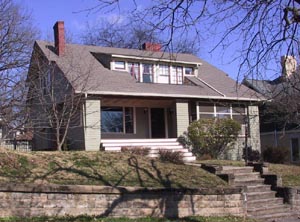
The Craftsman style is often termed "bungalow" or "Arts and Crafts" and all have some elements in common. The Craftsman style, which became popular in the early 1900s, was encouraged by the growing interest in open floor plans and a rejection of the ornamentation common in the Victorian era. Craftsman homes often had exposed rafters and other simple ornamentation designed to reveal their construction.
The Arts and Crafts movement gave rise to Craftsman styling. It came from the teachings of William Morris, John Ruskin and other English Theorists of the late 19th century who emphasized a human aspect of design through the use of simple, crated forms and honestly expressed materials.
Bungalows were first encountered in India by the English, and were buildings with low pitched gable roofs, wide eave overhangs, open floor plans and large porches.
In Knoxville and Knox County, these styles are usually referred to interchangeably, and possess many common design features.
Common characteristics:
- one- or one-and-a-half stories
- horizontal proportions
- wood walls and decorative detailing, including porch railings, shingles, and exposed rafters
- multiple gable roofs
- carefully crafted details
- use of brick, wood and carved stone
- naturalistic and geometric forms
- picturesque massing
Two types of late 19th and early 20th century housing types often referred to as styles are really derived from a description of the floor plan of the building. Stylistic details of different eras are used to embellish both of these: the American Four Square and the Shotgun
Dutch Colonial Revival

Based on the style of houses built by the Dutch settlers on New Amsterdam (New York) in the 1600s, this style acquired popularity between 1900 and World War II. The style can be found in the Park City community, and in Lindbergh Forest, Island Home, Adair Gardens, Gibbs Drive, Fairmont Park, North Hills, Holston Hills, and Sequoyah Hills.
Common characteristics:
- symmetrical facades
- doorways ornamented with columns, sidelights and transoms
- gambrel roofs (i.e., a curving roof with a shape similar to a barn roof)
- multi-paned windows
- simple porticos at primary entrance
East Tennessee Vernacular
A distinctive style found in several counties in East Tennessee these houses are two stories in height, three bays in width and two rooms deep with a central hall. End chimneys flank each side of a gable end roof. A two-thirds or full front porch with a shed or hip roof appears on the front elevation. Simple transoms and little or no decorative ornamentation are original to the structure. The houses have a one story rear addition, usually two-thirds of the width of the front section, which includes a porch that runds the length of the ell. Most of these houses were built between 1840 and the early 1900s.
Eastlake/Shingle
The Eastlake/Shingle style was popular at the same time as Queen Anne styles and is very similar to it. Eastlake design characteristics are borrowed from the interior design details developed by Charles Eastlake. The style is more vertical than the Queen Anne style, with more massive wood trim, usually formed by a chisel or gouge. Rolls of spindles and beaded trim are common, and upper stories of homes are often covered with patterned wood shingles.
Common characteristics:
- wood construction
- decorative wooden planks (or "stick work") which outline the underlying wood frame structure
- intricate wooden details, such as lathe-turned spindles and jigsaw-cut brackets
New architectural styles were arriving in Knoxville after the turn of the 20th century, and many of them were based on earlier design eras. The influence of the East Tennessee marble industry was profound, both in providing materials for houses and commercial buildings, and also in creating personal wealth that made their construction possible. Knoxville architect Charles Barber, son of George F. Barber received his architectural education in Paris, and returned to Knoxville to design many of the impressive residences found in Knoxville'sfirst automobile suburbs, including Sequoyah and Holston Hills.
Federal
The Federal, or Adam, style was popular in the United States from about 1780 to 1820, but in Knoxville the years of its popularity extended beyond the 1820s. The style was a refinement of the Georgian style, favored by the newly independent United States. It is box-shaped, two or more rooms deep, with doors and windows arranged symmetrically, but it is lighter and more delicate in feeling that Georgian styles. Some houses have projecting wins or rear ells.
Common characteristics:
- semi-circular fanlights
- small entry porches
- molded cornices with dentils
- Palladian windows
Georgian
Gothic Revival
Greek Revival
Italianate
Minimal Traditional
Neoclassical
Prairie School
Georgian
The Georgian style grew out of the Italian Renaissance and reached England in the mid-1600s. Architects such as Inigo Jones and Christopher Wren used its emphasis on classical details. American carpenters working in the English colonies in the 18th century used pattern books from England as guides. The style migrated to East Tennessee, where it was built by prosperous settlers who had outgrown their first log dwellings. Georgian houses are usually a one or two story box with symmetrical doors and windows
Common characteristics:
- gable roofs
- paneled, centered front doors
- transoms and sidelights
- cornice moldings
- double hung windows with six to twelve lights
Gothic Revival

The Gothic Revival style began in England in 1749; the first documented American example was designed by Alexander Jackson Davis in 1832. Most Gothic Revival houses were constructed between 1840 and 1870, although a few later examples do exist. The style was also used extensively in constructing churches, because its references to the medieval cathedrals of Europe were favored by many congregations. Features of the style in residential construction include steeply pitched roofs, usually with side gables and cross gables which are centered or paired, decorated bargeboards at eaves and one story porches with arched trim. In larger, ceremonial buildings, crenallated parapets, and arched windows with tracery are also found.
Greek Revival
The Greek Revival style was the dominant architectural style in the United States between 1825 and 1860, following settlers as they moved west. The style grew out of the interest in classical buildings that occurred in the late 19th century, and was encouraged by sympathy for Greece's war for independence (1821-1830) and the War of 1812, which diminished American interest in British influence (Georgian and Federal styles). Features include low pitched gable or hip roofs, a wide band of trim at the cornice line, porches supported by prominent square or rounded columns, transoms and sidelights at the main entry, and small paned double or triple hung wood windows.
Italianate
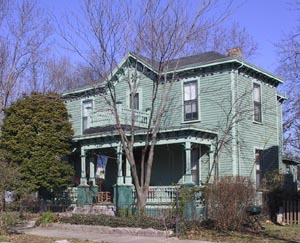
The Italianate style began in England as part of the Picturesque movement, which emphasized rambling, informal farmhouses. They were modified and adapted in the United States. The style was publicized here by Andrew Jackson Downing, and quickly eclipsed the Gothic Revival style. Italianate design emphasizes windows, cornices, porches and doorways. Windows are usually glazed with one or two panes, and may have arched windows tops. Brackets often appear at window pediments, and paired and tripled windows are frequent. Arch eaves brackets are placed on a deep trim to support a cornice with a large overhang. Porches are usually one story, and the porch support is usually square with beveled corners. Paired doors may be present, and the doors usually have large pane glazing. The style generally dates from 1840 to 1880.
Post-Civil War styles were at first Victorian in character. One of the country'smost outstanding architects, George F. Barber, lived in Knoxville. Barber was connected with suburban expansion as it was fueled by the growing trolley lines, and many of this house designs can be found in the Old North Knoxville, Fourth & Gill, and Edgewood-Park City historic districts. Baumann and Baumann was another outstanding architectural firm. A number of Baumann designs remain, particularly in the Fort Sanders area. Baumann is also represented in Mechanicsville, although many buildings in Mechanicsville date from an earlier tradition
Minimal Traditional
This style, which started in the 1930s but became dominant in the years following World War II, was loosely based on the Tudor style of the 1920s and 1930s. There is often a prominent front gable, but the roof pitch is not as steep as those found in the Tudor Revival style. Traditional detailing is still included, the expansive front porches of earlier styles are not found, and brickwork often included massive chimneys. These houses can be found in many earlier neighborhoods, as vacant lots were slowly filled in. Good examples of the style are also found in North Hills and Fairmont Park.
Common characteristics:
- horizontal shape
- side gable roof with centered front cross gable
- entry porticos
- shallow pitched roofs
- little use of ornament
Neoclassical
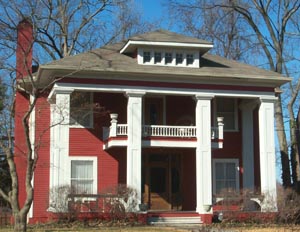
Facades of Neoclassical houses may feature columns the full height of the two-story building; however, one-story cottages are also present. A full or partial-width porch with columns may be found. Symmetrical front facades and multiple-pane glazing in double sash windows are usually present on the front facade.
Prairie School
The Prairie style was developed in the late-19th and early-20th centuries by Frank Lloyd Wright and other architects as "a modern architecture for a democratic American society." Only a few examples are found in Knoxville, but the style was so dominant that it influenced later common designs.
Common characteristics:
- horizontal proportions
- flat brick or stucco walls, often outlined with wooden strips of contrasting color
- windows with abstract, geometric ornament
- hip or gable roofs with wide, overhanging eaves
Queen Anne
Ranch
Renaissance Revival
Shotgun
Spanish Revival
Tudor Revival
Queen Anne
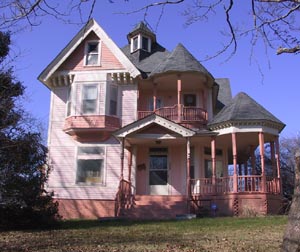
The Queen Anne style was popularized by a 19th century architect, Richard Norman Shaw, but has nothing to do with the time of Queen Anne'sreign, which was from 1702-1714. The first American example of Queen Anne style is thought to be the Watts Sherman house in Newport, Rhode Island, built in 1874. By 1880, architectural pattern books were spreading the style throughout the country. The expanding railroads helped to popularize it by making pre-cut architectural details widely available.
Varied architectural elements are part of the Queen Anne style, and details from other styles are reinterpreted in Queen Anne design. The houses have irregular floor plans, large porches, and elaborate decoration on exterior surfaces. In Knoxville, George F. Barber and Baumann and Baumann designed many of the more elaborate Queen Anne residences.
Common characteristics:
- rich but simple ornamentation
- variety of materials, including wood, terra cotta, stone, and pressed metal
- expansive porches
- pressed metal bays and turrets
- irregular roofline with many dormers and chimneys
- colored slate, patterned oversize asphalt shingles or terra cotta tiles used as roof coverings
- wood shingles in diamond, fishscale or square patterns used on gables.
- turned or chamfered wood porch columns and spindles, lacy spandrels, beaded balusters
- leaded, stained glass windows and windows with intricate pane patterns
- sawn wood attic vents
- transoms and sidelights at primary entries
A variation of this style is the Queen Anne Cottage, which is usually one- or one- and one-half stories in height, with many of the ornamental features found on larger homes. Commercial buildings are also embellished with Queen Anne ornamentation
Ranch
Ranch houses are usually one story in height with a lot-pitched roof and broad facades, porch roof supports, decorative shutters, or other details that refer to the Colonial Revival stylistic precedent. The split-level style, with wings and sunken garages, is a variation from this era, as is the Contemporary, with its wide eaves and low-pitched or flat roofs. Windows in all these styles are usually single pane sashes, often aluminum.
Renaissance Revival
This style of building features low-pitched hipped or flat roofs. Hipped roofs are covered by terra cotta or cement tiles. Arches above doors or windows or on porches are common. A symmetrical facade and recessed entry porches are used. This style is less common than Craftsman, Tudor or Colonial Revival styles. Windows are usually double hung, with multiple panes in the upper sash and one pane in the lower.
Shotgun
The term "shotgun" refers to a floor plan arrangement in which the rooms of the house open in succession from the front to rear without a hallway. The term "shotgun" comes from the description that a shotgun could be fired in the front door and would exit through the rear doorway without hitting any intervening walls. These houses were usually worker housing. Shotgun homes can be found in Mechanicsville, Edgewood-Park City, Old North Knoxville and Fourth & Gill.
Common characteristics:
- one story height
- front gable roofs with shed roofed porches
- simple wood trim reflecting the design era prevalent when the house was built, and usually either Victorian-era or Craftsman trim
Spanish Revival
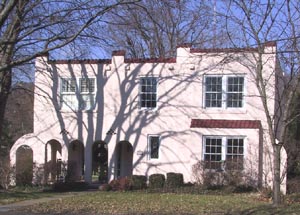
This style is based on Spanish colonial and Mexican buildings that were built in California, Texas and the American Southwest between the early 1600s and 1840s. The style gained popularity a second time as a revival style during the 1920s. It can be found in many of Knoxville'searly 20th century neighborhoods, with Fairmont Park, North Hills and Lindbergh Forest having particularly good examples of the style.
Common characteristics:
- brick or stucco walls
- twisting columns and decorative shields made of terra cotta
- round arched windows
- elaborately rounded roof parapets based on Spanish colonial missions
- clay tile roofs
Tudor Revival
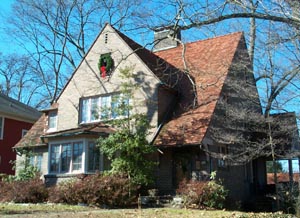
Sometimes called "stockbroker Tudor," this style is based on English domestic architecture from the 1500s and 1600s. It gained great popularity as a residential style in America during the early 20th century, and can be found in such neighborhoods as Sequoyah Hills, Holston Hills, Fairmont Park and Adair Gardens.
Common characteristics:
- steeply pitched gable roofs
- use of stucco, particularly in ends of gables
- rounded bays and turrets
- irregular massing
- massive chimneys

